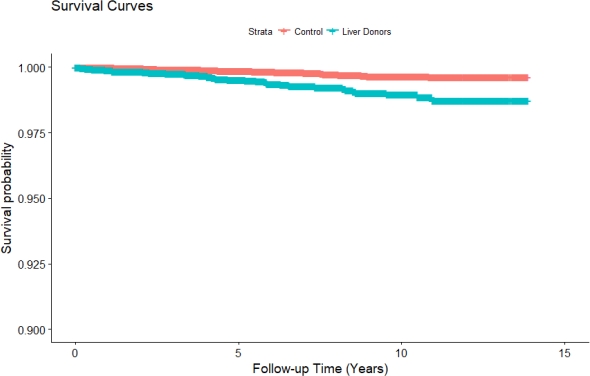Long-Term Outcomes after Living Liver Donation: Analysis of National Data Base
S. Hong, N-.J. Yi, K. Yoon, J-.H. Cho, J-.M. Lee, H. Kim, K. Lee, K. Suh.
Surgery, Seoul National University College of Medicine, Seoul, Korea.
Meeting: 2018 American Transplant Congress
Abstract number: D218
Keywords: Donation, Liver transplantation, Living-related liver donors
Session Information
Session Name: Poster Session D: Liver: Living Donors and Partial Grafts
Session Type: Poster Session
Date: Tuesday, June 5, 2018
Session Time: 6:00pm-7:00pm
 Presentation Time: 6:00pm-7:00pm
Presentation Time: 6:00pm-7:00pm
Location: Hall 4EF
Background: Every year, more than 800 healthy people undergo hepatic resection for living liver donation in Korea. Although 27 years has passed since the first living donor liver transplantation has been reported, the long-term outcome of living liver donor still remains in question. The aim of this study is to determine the long-term outcome of living donor using national data base.
Methods: Live donors were drawn from a national registry of 10,116 live liver donors in Korea between February 9, 2000, and December 31, 2015. Population we selected for potential controls was Korean National Health Insurance System – National Sample Cohort (NHIS-NSC, 2002-2013) which is a nationally representative random sample of 1,025,340 individuals, account for 2.2% of the entire population in 2002. Excluding those with contraindications to be organ donors, 7,538 donors were 1:3 individually matched using sex and 5-year age group.
Results: The donor mortality rate was 0.2% (53/10,116) with 15-year survival rate 98.8%. After matching, there were 44 deaths in liver donors (n=7,538) and 40 deaths in controls (n=22,614) during the study period.  The most common cause of death was suicide in both donors and controls which consists about 35% (n=30) in total deaths. Overall risk of death was higher in liver donors than controls (HR 3.30, 95% CI, 2.15 – 5.06). When analyzed according to the causes of death, risk of death from suicide (HR 3.43, 95% CI, 1.67 – 7.03), cancer (HR 21.00, 95% CI, 2.59 – 170.69) and unknown or unclassified reason (HR 3.43, 95% CI, 1.24 – 9.46) were significantly higher in liver donors than controls.
The most common cause of death was suicide in both donors and controls which consists about 35% (n=30) in total deaths. Overall risk of death was higher in liver donors than controls (HR 3.30, 95% CI, 2.15 – 5.06). When analyzed according to the causes of death, risk of death from suicide (HR 3.43, 95% CI, 1.67 – 7.03), cancer (HR 21.00, 95% CI, 2.59 – 170.69) and unknown or unclassified reason (HR 3.43, 95% CI, 1.24 – 9.46) were significantly higher in liver donors than controls.
Conclusion: This study has generated reliable data on long-term outcome of live liver donor using national data base. Keeping in mind that donor deaths occur, more attention should be paid in hepatic resection for live liver donor.
CITATION INFORMATION: Hong S., Yi N-.J., Yoon K., Cho J-.H., Lee J-.M., Kim H., Lee K., Suh K. Long-Term Outcomes after Living Liver Donation: Analysis of National Data Base Am J Transplant. 2017;17 (suppl 3).
To cite this abstract in AMA style:
Hong S, Yi N-J, Yoon K, Cho J-H, Lee J-M, Kim H, Lee K, Suh K. Long-Term Outcomes after Living Liver Donation: Analysis of National Data Base [abstract]. https://atcmeetingabstracts.com/abstract/long-term-outcomes-after-living-liver-donation-analysis-of-national-data-base/. Accessed December 27, 2025.« Back to 2018 American Transplant Congress
